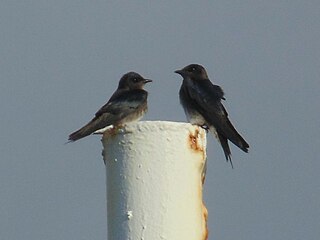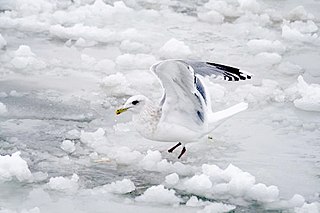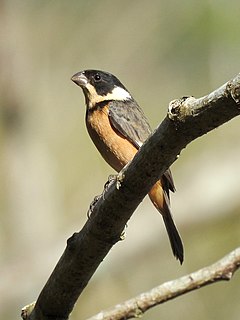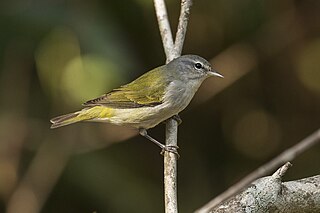
The Accipitriformes are an order of birds that includes most of the diurnal birds of prey – including hawks, eagles, vultures, and kites, but not falcons.

The black-faced antthrush, is a species of passerine bird in the family Formicariidae.

The Cuban martin is a large swallow endemic to Cuba.

The typical honeycreepers form a genus Cyanerpes of small birds in the tanager family Thraupidae. They are found in the tropical New World from Mexico south to Brazil. They occur in the forest canopy, and, as the name implies, they are specialist nectar feeders with long curved bills.
The nine-primaried oscines is a group of bird families in the suborder Passeri (oscines) of the Passeriformes. The composition of the group has changed since the term was first introduced but is now considered to consist of seven major families: Fringillidae, Emberizidae, Cardinalidae, Thraupidae, Passerellidae, Parulidae and Icteridae. When Fringillidae is omitted the remaining six families are referred to as the "New World" nine-primaried oscines.

The flame-colored tanager, formerly known as the stripe-backed tanager, is a medium-sized American songbird. Formerly placed in the tanager family Thraupidae, other members of its genus and it are now classified in the cardinal family Cardinalidae. The species's plumage and vocalizations are similar to other members of the cardinal family.

Thayer's gull is a subspecies of the Iceland gull. It is a large gull native to North America that breeds in the Arctic islands of Canada and winters primarily on the Pacific coast, from southern Alaska to the Gulf of California, though there are also wintering populations on the Great Lakes and the upper Mississippi River. The species has occurred as a vagrant to Japan, Denmark, and other parts of western Europe.

The cinnamon-rumped seedeater is a passerine bird in the typical seedeater genus Sporophila.

New World sparrows are a group of mainly New World passerine birds, forming the family Passerellidae. They are seed-eating birds with conical bills, brown or gray in color, and many species have distinctive head patterns.

Catamenia is a genus of atypical seedeaters. Formerly placed in the Emberizidae, they are now placed in the tanager family Thraupidae.

The pardusco is a species of tanager that is endemic to woodland near the timberline in the Andes of central Peru. It is the only member of the genus Nephelornis. This small olive-brown bird is typically seen in groups, which sometimes join mixed species flocks. It has a small range, but is locally fairly common, and consequently considered to be of least concern by BirdLife International and IUCN.

Conothraupis is a genus of South American birds in the tanager family Thraupidae.

The Amethyst-throated Mountain-gem or amethyst-throated hummingbird is a species of hummingbird in the family Trochilidae. It is found in El Salvador, Guatemala, Honduras, and is endemic to Mexico. Its natural habitat is subtropical or tropical moist montane forest. One confirmed sighting of a male Amethyst-throated hummingbird had occurred in West Texas by Cornell Lab of Ornithology on one of their online live webcams on October 15, 2016.

The yellow-shouldered grosbeak is a species of bird in the tanager family Thraupidae. It is the only member of its genus Parkerthraustes. It is found in Bolivia, Brazil, Colombia, Ecuador, and Peru. Its natural habitat is subtropical or tropical moist lowland forests.

Notharchus is a genus of puffbird in the Bucconidae family.

The Cuban warblers are a genus, Teretistris, and family, Teretistridae, of birds endemic to Cuba and its surrounding cays. Until 2002 they were thought to be New World warblers, but DNA studies have shown that they are not closely related to that family. The family consists of two species, the yellow-headed warbler and the Oriente warbler. Both species are found in forest and scrub, with the yellow-headed warbler ranging in the west of the island and the Oriente warbler in the east. The Cuban warblers are 13 cm (5.1 in) long and have similar yellow and grey plumage.

Leiothlypis is a genus of New World warbler, formerly classified within the genus Oreothlypis or Vermivora.
The Guerrero brush finch is a species of New World sparrow that is endemic to Mexico. The species was named in honor of Mr. Carl Kuehner, a member of the board of directors of the U.S. National Fish and Wildlife Foundation.

Nesophlox is a genus in the family of Hummingbirds. It consists of two endemic hummingbirds of the Bahamas.




















